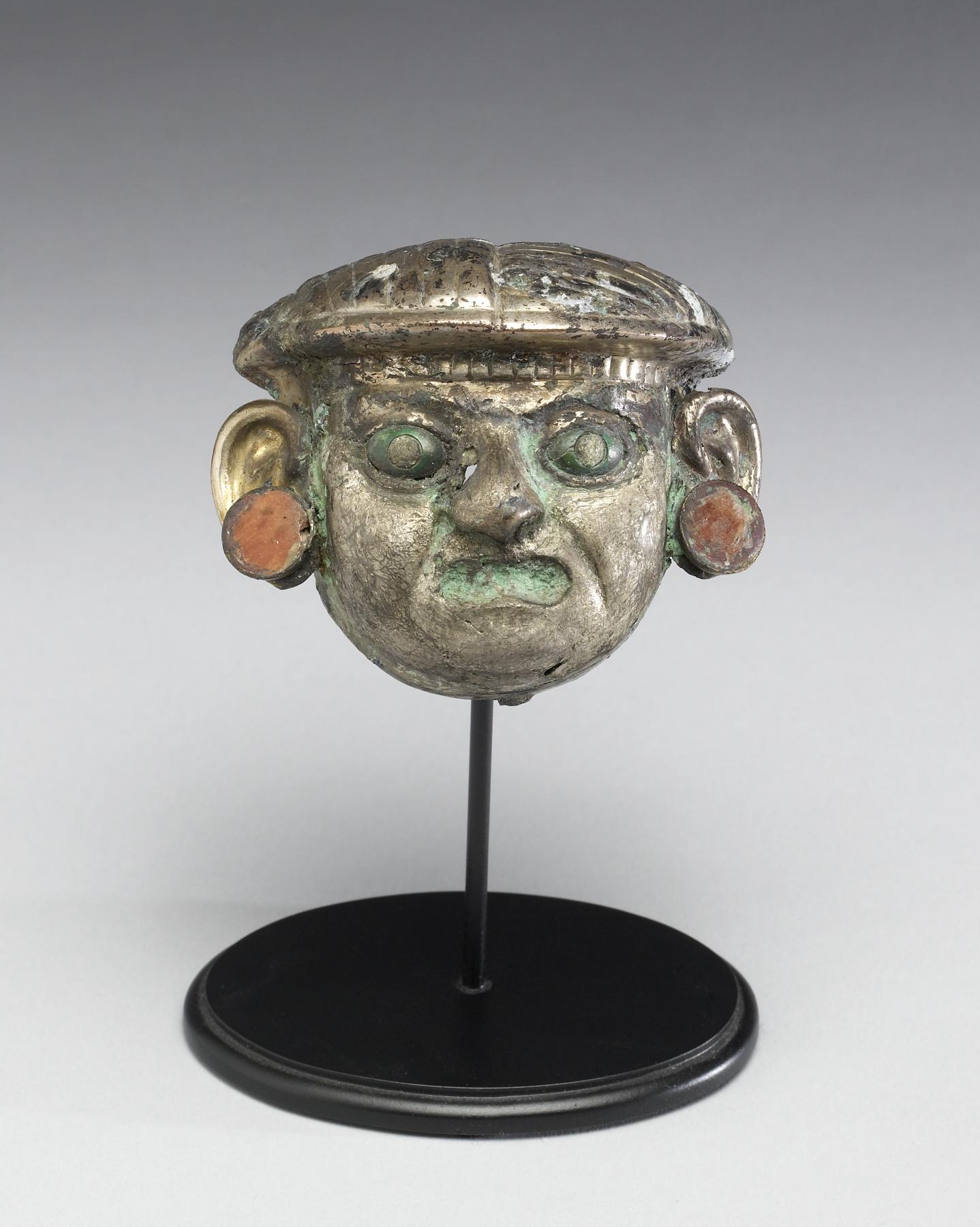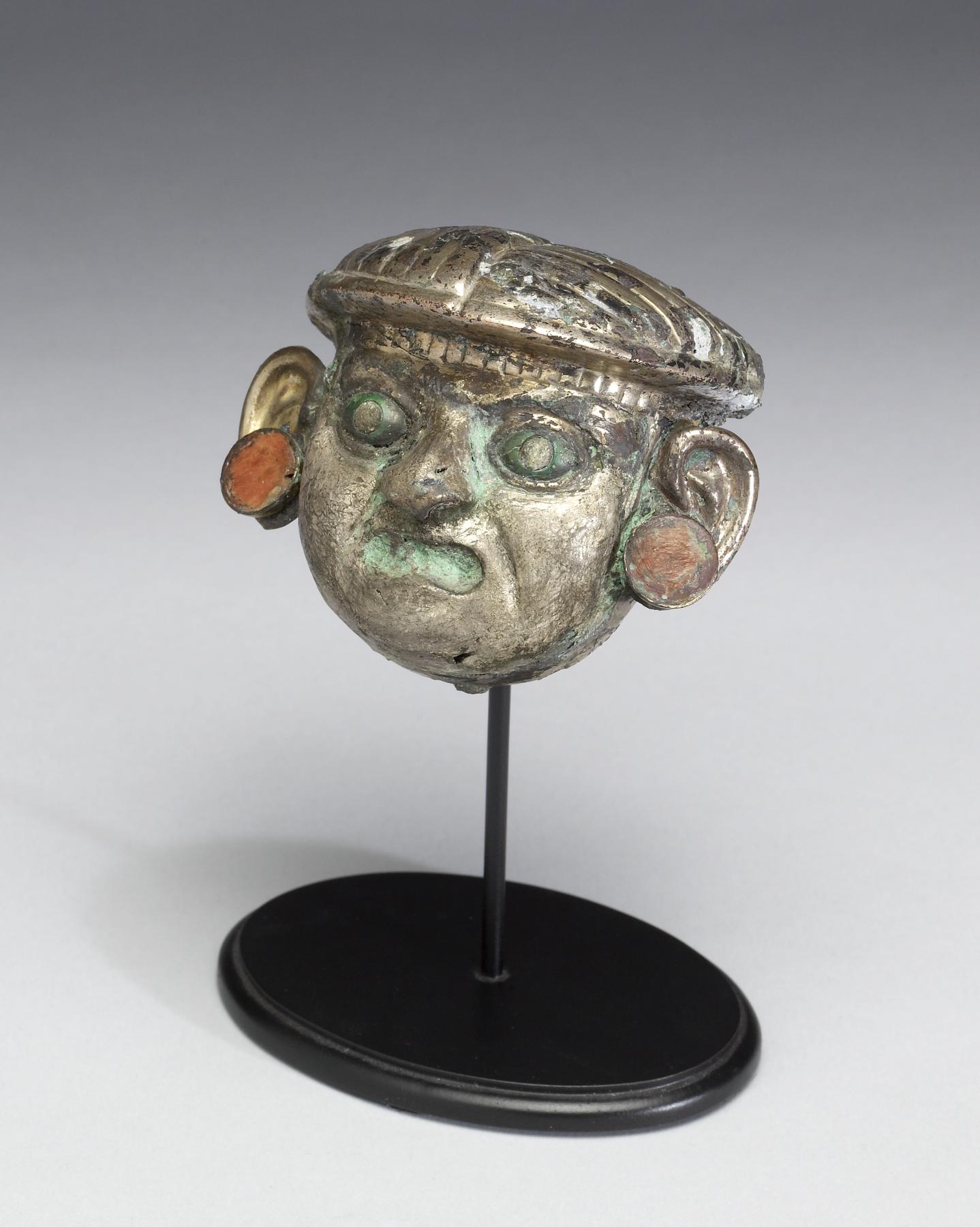Head Effigy Bead
(Ancient Americas )
The Moche developed the first state-level political system in the ancient Andes during the Early Intermediate Period (200 BCE-500 CE) in response to wide-ranging events throughout the northern coast. The region's growing populations and occasional droughts of years' duration heightened competition for arable land and precious water. A new elite class, the kuraka, arose to meet the challenges of effective survival by exerting control over coastal resources, from land and water allocations to the human labor needed for such crucial construction projects as large-scale irrigation systems and monumental architecture conveying socio-political and spiritual power. The kuraka also controlled the all-important local and long-distance exchange networks that ensured the availability of both basic commodities and luxury goods. The authority of the kuraka was based on an ideology that claimed their descent from mythic founders. Thus, although the gods were the ultimate source of power, mythical human figures became principal kingpins in the Moche politico-religious schematic. The five major river valleys of the northern coast were united, to varying degrees, under the commanding kuraka socio-political framework. They not only administered all manner of subsistence, social, and religious affairs, but also sponsored the production of prodigious amounts of artworks that denoted high status and underscored the ideological basis of sociopolitical hierarchy Members of the kuraka were adorned with finely crafted jewelry made of silver and gold and often embellished with precious shell and stone inlays. Noblemen buried in the royal tombs of Sipán, an important Moche center, were festooned in all manner of precious metal adornments whose imagery indicated their political office and specified their ceremonial roles during enactments of the Sacrifice Ceremony, which frequently was represented on Moche pottery. This large silver bead may be the head of the so-called Decapitator, a key supernatural being associated with human sacrifice and warrior power. The lord buried in Sipán Tomb 1 was dressed as the Warrior Priest of the Sacrifice Ceremony. He was adorned with jewelry depicting this fearsome being, which thereby connected him to ritual warfare and decapitation sacrifice. Similar gold, copper, and silver effigy bead necklaces bedecked the individuals in Tombs 2 and 3, some beads having the fanged teeth of the deity, whereas others feature humanlike teeth. In this example, the hair, face, and large earflares recall human portrayals, whereas the shape of the mouth, which likely makes reference to the snarl of a feline predator, is more typical of the Decapitator supernatural being. As such, this large silver bead may have alluded to the wearer's spiritual power.
Provenance
Provenance (from the French provenir, 'to come from/forth') is the chronology of the ownership, custody, or location of a historical object. Learn more about provenance at the Walters.
Ron Messick Fine Arts, Santa Fe, New Mexico [date and mode of acquisition unknown]; John G. Bourne, 1990s, by purchase; by bequest to Walters Art Museum, 2017.
Exhibitions
| 2012-2013 | Exploring Art of the Ancient Americas: The John Bourne Collection Gift. The Walters Art Museum, Baltimore; Frist Center for the Visual Arts, Nashville. |
Geographies
Peru, North Coast (Place of Origin)
Measurements
H: 2 9/16 x W: 3 1/16 x D: 1 7/16 in. (6.5 x 7.7 x 3.7 cm)
Credit Line
Bequest of John G. Bourne, 2017
Location in Museum
Not on view
Accession Number
In libraries, galleries, museums, and archives, an accession number is a unique identifier assigned to each object in the collection.
In libraries, galleries, museums, and archives, an accession number is a unique identifier assigned to each object in the collection.
2009.20.261






